Commercial and Contract Management: Contractor's Performance Report
VerifiedAdded on 2019/09/22
|9
|2507
|383
Report
AI Summary
This report examines contractor performance and obligations within a company, specifically focusing on the energy business. It explores the importance of effective contract management, highlighting the need for clear obligations and performance standards. The report analyzes the impact of poor ...
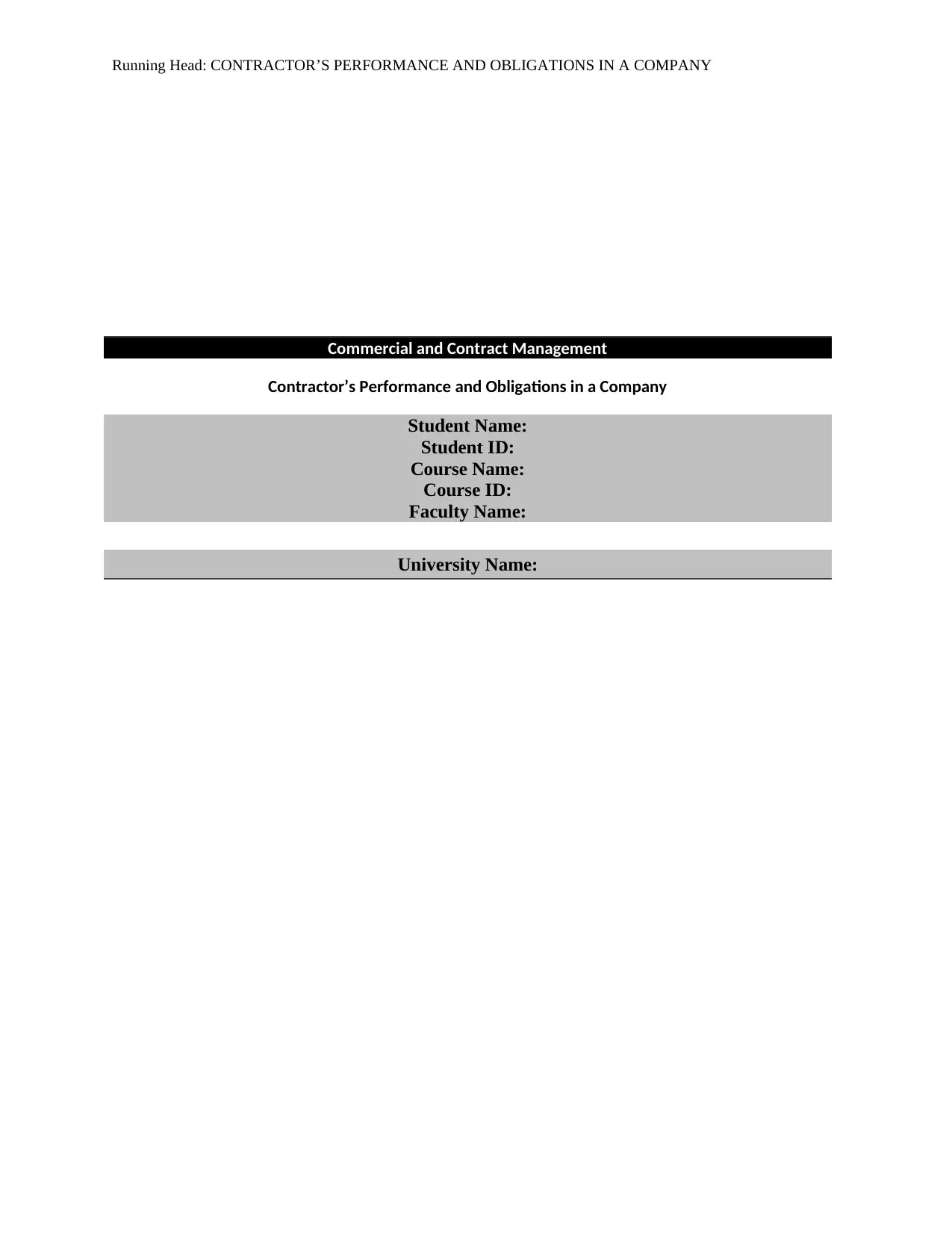
Running Head: CONTRACTOR’S PERFORMANCE AND OBLIGATIONS IN A COMPANY
Commercial and Contract Management
Contractor’s Performance and Obligations in a Company
Student Name:
Student ID:
Course Name:
Course ID:
Faculty Name:
University Name:
Commercial and Contract Management
Contractor’s Performance and Obligations in a Company
Student Name:
Student ID:
Course Name:
Course ID:
Faculty Name:
University Name:
Paraphrase This Document
Need a fresh take? Get an instant paraphrase of this document with our AI Paraphraser
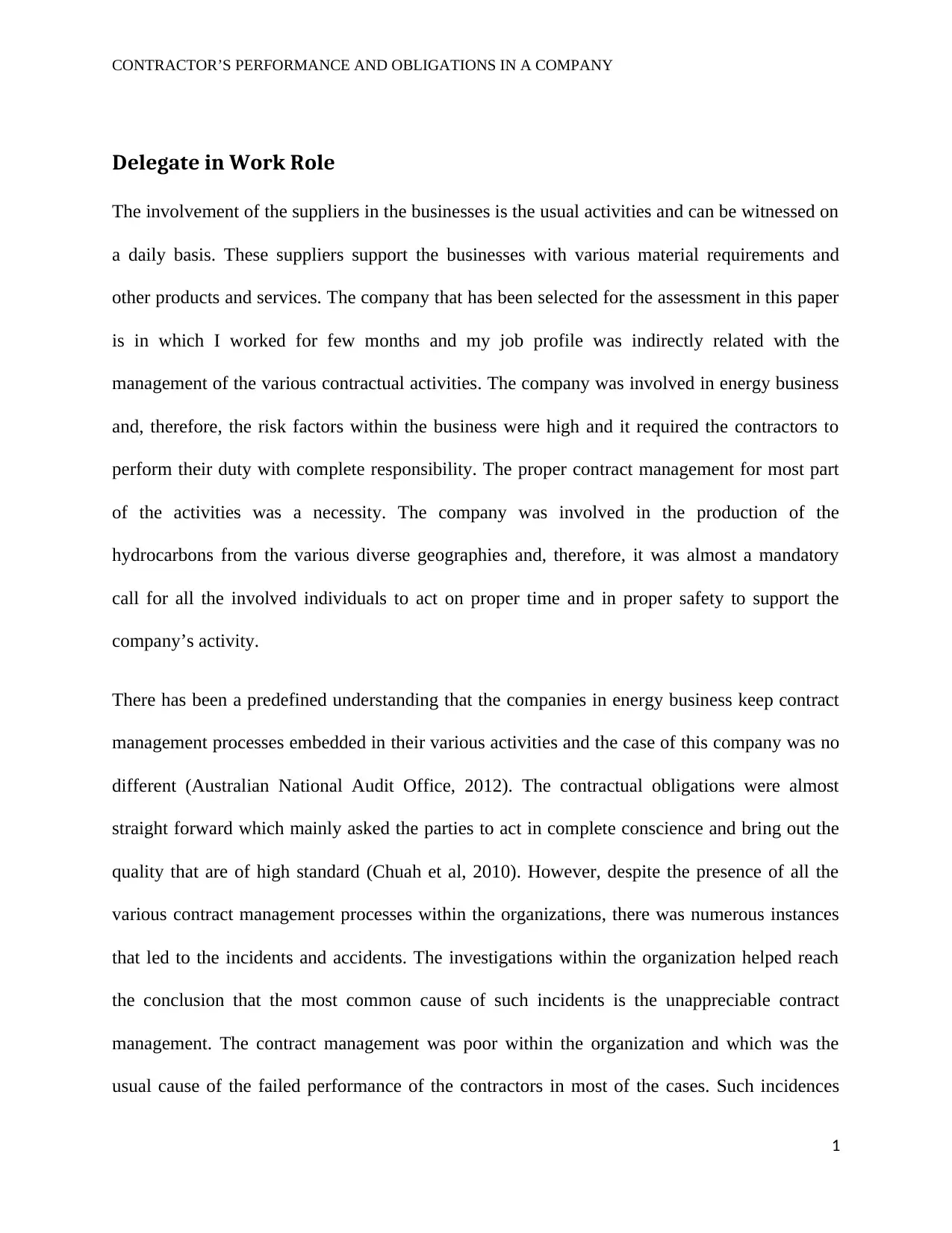
CONTRACTOR’S PERFORMANCE AND OBLIGATIONS IN A COMPANY
Delegate in Work Role
The involvement of the suppliers in the businesses is the usual activities and can be witnessed on
a daily basis. These suppliers support the businesses with various material requirements and
other products and services. The company that has been selected for the assessment in this paper
is in which I worked for few months and my job profile was indirectly related with the
management of the various contractual activities. The company was involved in energy business
and, therefore, the risk factors within the business were high and it required the contractors to
perform their duty with complete responsibility. The proper contract management for most part
of the activities was a necessity. The company was involved in the production of the
hydrocarbons from the various diverse geographies and, therefore, it was almost a mandatory
call for all the involved individuals to act on proper time and in proper safety to support the
company’s activity.
There has been a predefined understanding that the companies in energy business keep contract
management processes embedded in their various activities and the case of this company was no
different (Australian National Audit Office, 2012). The contractual obligations were almost
straight forward which mainly asked the parties to act in complete conscience and bring out the
quality that are of high standard (Chuah et al, 2010). However, despite the presence of all the
various contract management processes within the organizations, there was numerous instances
that led to the incidents and accidents. The investigations within the organization helped reach
the conclusion that the most common cause of such incidents is the unappreciable contract
management. The contract management was poor within the organization and which was the
usual cause of the failed performance of the contractors in most of the cases. Such incidences
1
Delegate in Work Role
The involvement of the suppliers in the businesses is the usual activities and can be witnessed on
a daily basis. These suppliers support the businesses with various material requirements and
other products and services. The company that has been selected for the assessment in this paper
is in which I worked for few months and my job profile was indirectly related with the
management of the various contractual activities. The company was involved in energy business
and, therefore, the risk factors within the business were high and it required the contractors to
perform their duty with complete responsibility. The proper contract management for most part
of the activities was a necessity. The company was involved in the production of the
hydrocarbons from the various diverse geographies and, therefore, it was almost a mandatory
call for all the involved individuals to act on proper time and in proper safety to support the
company’s activity.
There has been a predefined understanding that the companies in energy business keep contract
management processes embedded in their various activities and the case of this company was no
different (Australian National Audit Office, 2012). The contractual obligations were almost
straight forward which mainly asked the parties to act in complete conscience and bring out the
quality that are of high standard (Chuah et al, 2010). However, despite the presence of all the
various contract management processes within the organizations, there was numerous instances
that led to the incidents and accidents. The investigations within the organization helped reach
the conclusion that the most common cause of such incidents is the unappreciable contract
management. The contract management was poor within the organization and which was the
usual cause of the failed performance of the contractors in most of the cases. Such incidences
1
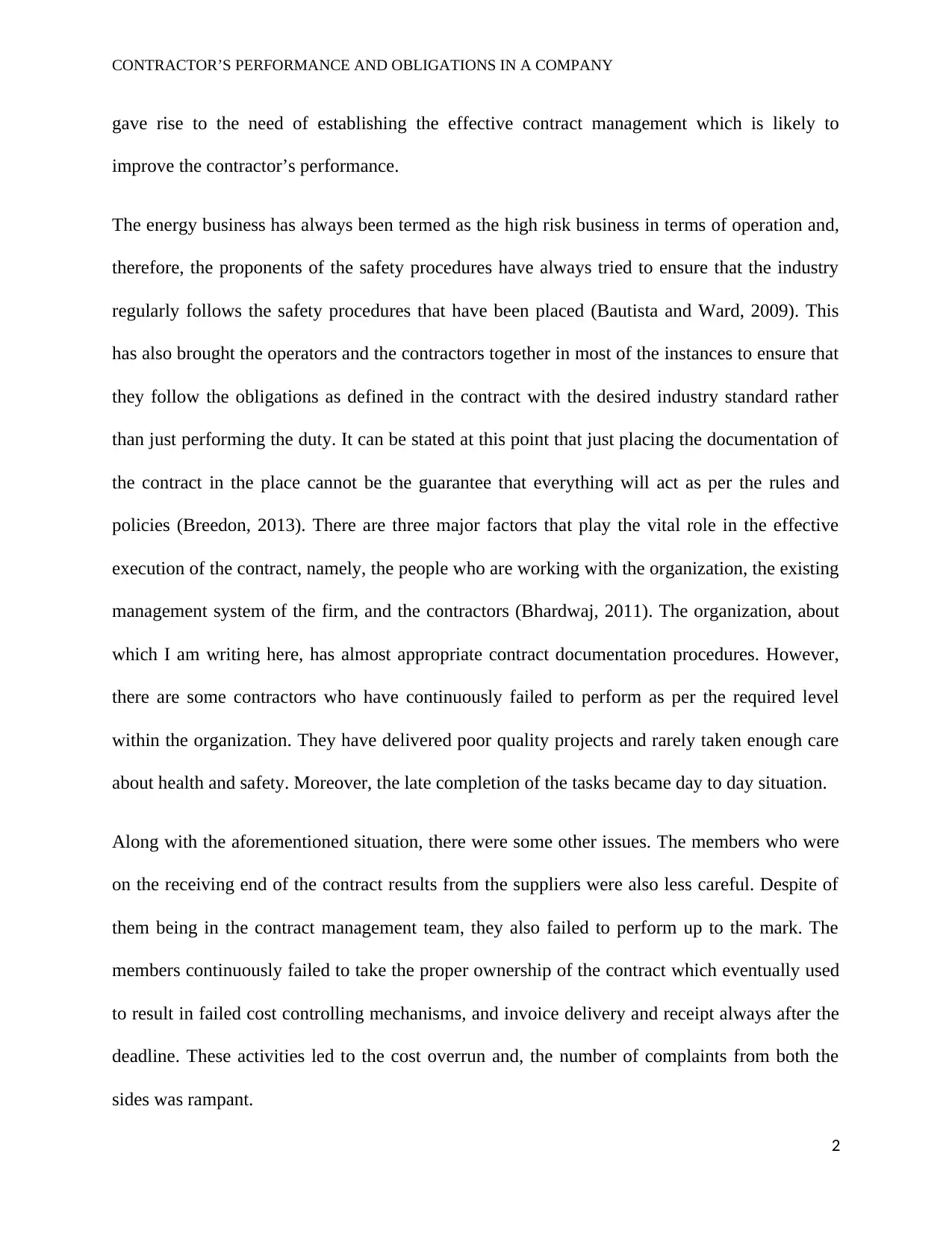
CONTRACTOR’S PERFORMANCE AND OBLIGATIONS IN A COMPANY
gave rise to the need of establishing the effective contract management which is likely to
improve the contractor’s performance.
The energy business has always been termed as the high risk business in terms of operation and,
therefore, the proponents of the safety procedures have always tried to ensure that the industry
regularly follows the safety procedures that have been placed (Bautista and Ward, 2009). This
has also brought the operators and the contractors together in most of the instances to ensure that
they follow the obligations as defined in the contract with the desired industry standard rather
than just performing the duty. It can be stated at this point that just placing the documentation of
the contract in the place cannot be the guarantee that everything will act as per the rules and
policies (Breedon, 2013). There are three major factors that play the vital role in the effective
execution of the contract, namely, the people who are working with the organization, the existing
management system of the firm, and the contractors (Bhardwaj, 2011). The organization, about
which I am writing here, has almost appropriate contract documentation procedures. However,
there are some contractors who have continuously failed to perform as per the required level
within the organization. They have delivered poor quality projects and rarely taken enough care
about health and safety. Moreover, the late completion of the tasks became day to day situation.
Along with the aforementioned situation, there were some other issues. The members who were
on the receiving end of the contract results from the suppliers were also less careful. Despite of
them being in the contract management team, they also failed to perform up to the mark. The
members continuously failed to take the proper ownership of the contract which eventually used
to result in failed cost controlling mechanisms, and invoice delivery and receipt always after the
deadline. These activities led to the cost overrun and, the number of complaints from both the
sides was rampant.
2
gave rise to the need of establishing the effective contract management which is likely to
improve the contractor’s performance.
The energy business has always been termed as the high risk business in terms of operation and,
therefore, the proponents of the safety procedures have always tried to ensure that the industry
regularly follows the safety procedures that have been placed (Bautista and Ward, 2009). This
has also brought the operators and the contractors together in most of the instances to ensure that
they follow the obligations as defined in the contract with the desired industry standard rather
than just performing the duty. It can be stated at this point that just placing the documentation of
the contract in the place cannot be the guarantee that everything will act as per the rules and
policies (Breedon, 2013). There are three major factors that play the vital role in the effective
execution of the contract, namely, the people who are working with the organization, the existing
management system of the firm, and the contractors (Bhardwaj, 2011). The organization, about
which I am writing here, has almost appropriate contract documentation procedures. However,
there are some contractors who have continuously failed to perform as per the required level
within the organization. They have delivered poor quality projects and rarely taken enough care
about health and safety. Moreover, the late completion of the tasks became day to day situation.
Along with the aforementioned situation, there were some other issues. The members who were
on the receiving end of the contract results from the suppliers were also less careful. Despite of
them being in the contract management team, they also failed to perform up to the mark. The
members continuously failed to take the proper ownership of the contract which eventually used
to result in failed cost controlling mechanisms, and invoice delivery and receipt always after the
deadline. These activities led to the cost overrun and, the number of complaints from both the
sides was rampant.
2
⊘ This is a preview!⊘
Do you want full access?
Subscribe today to unlock all pages.

Trusted by 1+ million students worldwide
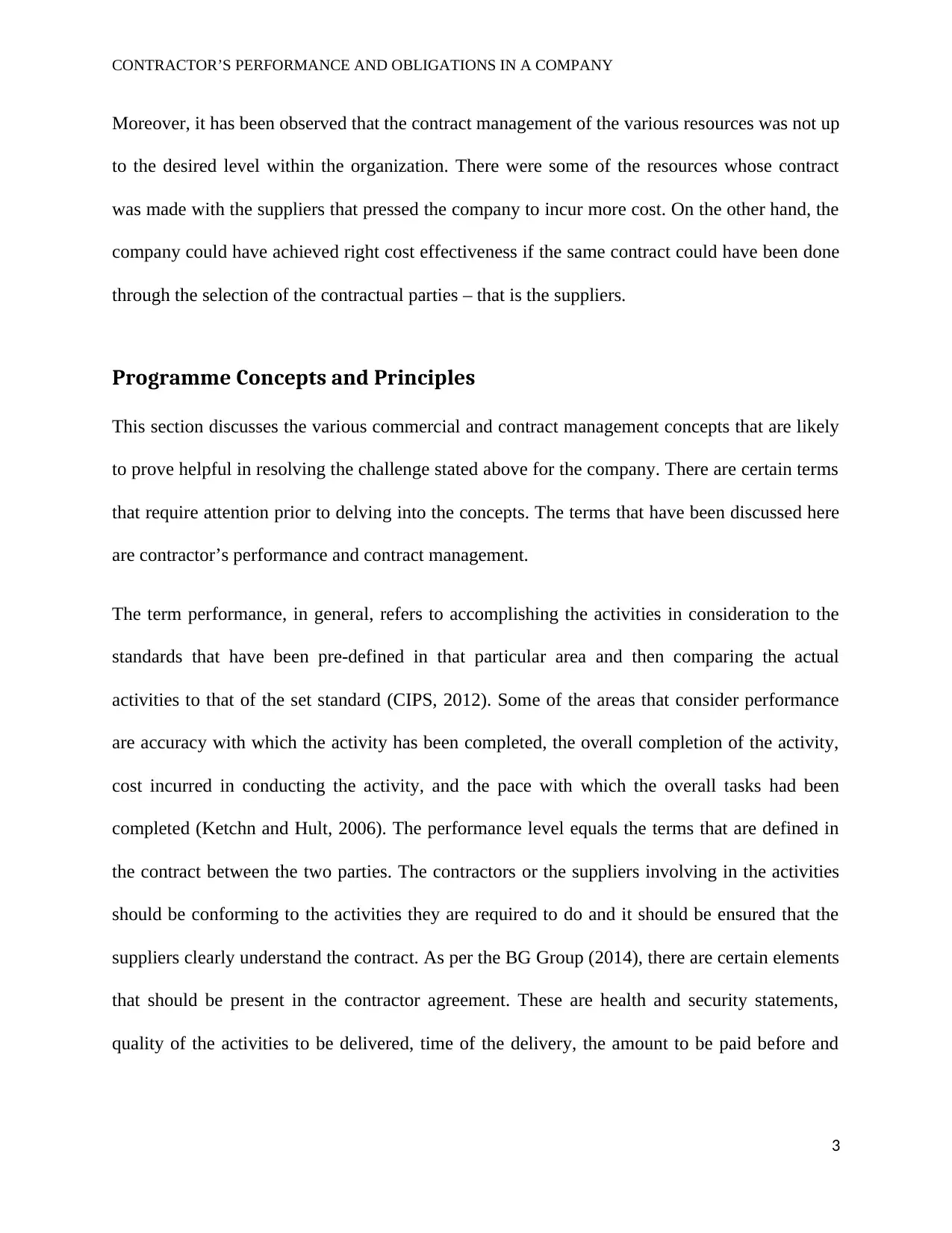
CONTRACTOR’S PERFORMANCE AND OBLIGATIONS IN A COMPANY
Moreover, it has been observed that the contract management of the various resources was not up
to the desired level within the organization. There were some of the resources whose contract
was made with the suppliers that pressed the company to incur more cost. On the other hand, the
company could have achieved right cost effectiveness if the same contract could have been done
through the selection of the contractual parties – that is the suppliers.
Programme Concepts and Principles
This section discusses the various commercial and contract management concepts that are likely
to prove helpful in resolving the challenge stated above for the company. There are certain terms
that require attention prior to delving into the concepts. The terms that have been discussed here
are contractor’s performance and contract management.
The term performance, in general, refers to accomplishing the activities in consideration to the
standards that have been pre-defined in that particular area and then comparing the actual
activities to that of the set standard (CIPS, 2012). Some of the areas that consider performance
are accuracy with which the activity has been completed, the overall completion of the activity,
cost incurred in conducting the activity, and the pace with which the overall tasks had been
completed (Ketchn and Hult, 2006). The performance level equals the terms that are defined in
the contract between the two parties. The contractors or the suppliers involving in the activities
should be conforming to the activities they are required to do and it should be ensured that the
suppliers clearly understand the contract. As per the BG Group (2014), there are certain elements
that should be present in the contractor agreement. These are health and security statements,
quality of the activities to be delivered, time of the delivery, the amount to be paid before and
3
Moreover, it has been observed that the contract management of the various resources was not up
to the desired level within the organization. There were some of the resources whose contract
was made with the suppliers that pressed the company to incur more cost. On the other hand, the
company could have achieved right cost effectiveness if the same contract could have been done
through the selection of the contractual parties – that is the suppliers.
Programme Concepts and Principles
This section discusses the various commercial and contract management concepts that are likely
to prove helpful in resolving the challenge stated above for the company. There are certain terms
that require attention prior to delving into the concepts. The terms that have been discussed here
are contractor’s performance and contract management.
The term performance, in general, refers to accomplishing the activities in consideration to the
standards that have been pre-defined in that particular area and then comparing the actual
activities to that of the set standard (CIPS, 2012). Some of the areas that consider performance
are accuracy with which the activity has been completed, the overall completion of the activity,
cost incurred in conducting the activity, and the pace with which the overall tasks had been
completed (Ketchn and Hult, 2006). The performance level equals the terms that are defined in
the contract between the two parties. The contractors or the suppliers involving in the activities
should be conforming to the activities they are required to do and it should be ensured that the
suppliers clearly understand the contract. As per the BG Group (2014), there are certain elements
that should be present in the contractor agreement. These are health and security statements,
quality of the activities to be delivered, time of the delivery, the amount to be paid before and
3
Paraphrase This Document
Need a fresh take? Get an instant paraphrase of this document with our AI Paraphraser
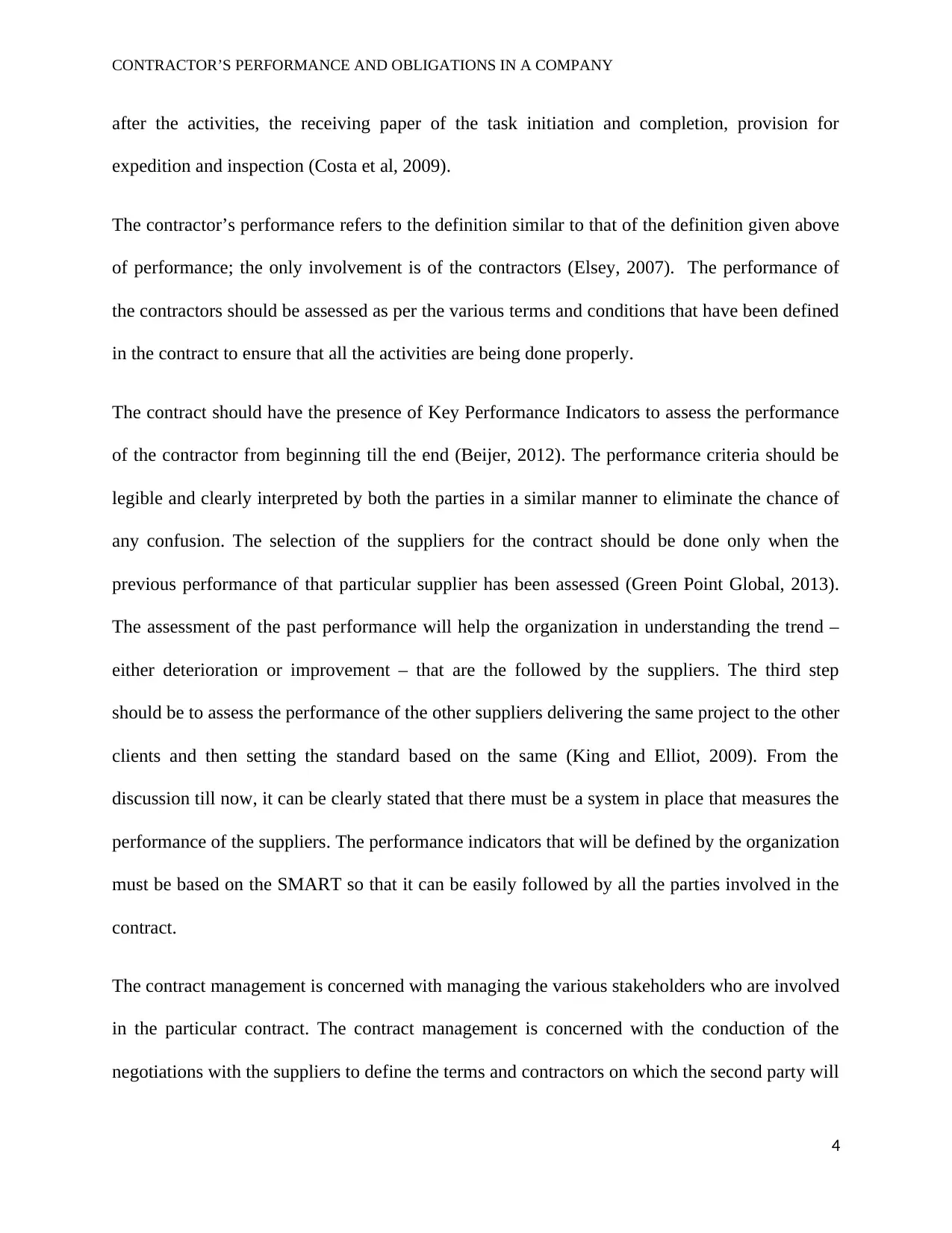
CONTRACTOR’S PERFORMANCE AND OBLIGATIONS IN A COMPANY
after the activities, the receiving paper of the task initiation and completion, provision for
expedition and inspection (Costa et al, 2009).
The contractor’s performance refers to the definition similar to that of the definition given above
of performance; the only involvement is of the contractors (Elsey, 2007). The performance of
the contractors should be assessed as per the various terms and conditions that have been defined
in the contract to ensure that all the activities are being done properly.
The contract should have the presence of Key Performance Indicators to assess the performance
of the contractor from beginning till the end (Beijer, 2012). The performance criteria should be
legible and clearly interpreted by both the parties in a similar manner to eliminate the chance of
any confusion. The selection of the suppliers for the contract should be done only when the
previous performance of that particular supplier has been assessed (Green Point Global, 2013).
The assessment of the past performance will help the organization in understanding the trend –
either deterioration or improvement – that are the followed by the suppliers. The third step
should be to assess the performance of the other suppliers delivering the same project to the other
clients and then setting the standard based on the same (King and Elliot, 2009). From the
discussion till now, it can be clearly stated that there must be a system in place that measures the
performance of the suppliers. The performance indicators that will be defined by the organization
must be based on the SMART so that it can be easily followed by all the parties involved in the
contract.
The contract management is concerned with managing the various stakeholders who are involved
in the particular contract. The contract management is concerned with the conduction of the
negotiations with the suppliers to define the terms and contractors on which the second party will
4
after the activities, the receiving paper of the task initiation and completion, provision for
expedition and inspection (Costa et al, 2009).
The contractor’s performance refers to the definition similar to that of the definition given above
of performance; the only involvement is of the contractors (Elsey, 2007). The performance of
the contractors should be assessed as per the various terms and conditions that have been defined
in the contract to ensure that all the activities are being done properly.
The contract should have the presence of Key Performance Indicators to assess the performance
of the contractor from beginning till the end (Beijer, 2012). The performance criteria should be
legible and clearly interpreted by both the parties in a similar manner to eliminate the chance of
any confusion. The selection of the suppliers for the contract should be done only when the
previous performance of that particular supplier has been assessed (Green Point Global, 2013).
The assessment of the past performance will help the organization in understanding the trend –
either deterioration or improvement – that are the followed by the suppliers. The third step
should be to assess the performance of the other suppliers delivering the same project to the other
clients and then setting the standard based on the same (King and Elliot, 2009). From the
discussion till now, it can be clearly stated that there must be a system in place that measures the
performance of the suppliers. The performance indicators that will be defined by the organization
must be based on the SMART so that it can be easily followed by all the parties involved in the
contract.
The contract management is concerned with managing the various stakeholders who are involved
in the particular contract. The contract management is concerned with the conduction of the
negotiations with the suppliers to define the terms and contractors on which the second party will
4
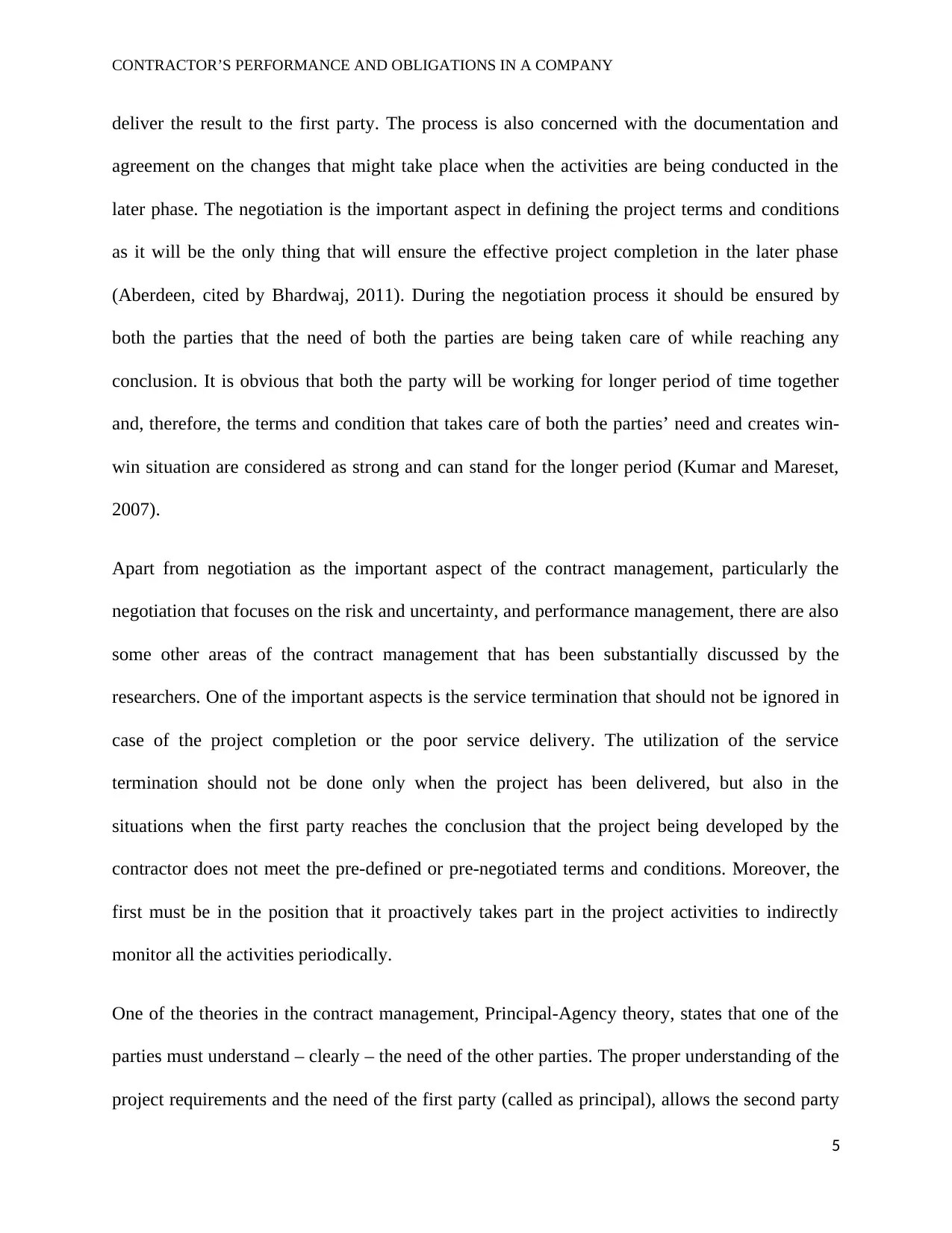
CONTRACTOR’S PERFORMANCE AND OBLIGATIONS IN A COMPANY
deliver the result to the first party. The process is also concerned with the documentation and
agreement on the changes that might take place when the activities are being conducted in the
later phase. The negotiation is the important aspect in defining the project terms and conditions
as it will be the only thing that will ensure the effective project completion in the later phase
(Aberdeen, cited by Bhardwaj, 2011). During the negotiation process it should be ensured by
both the parties that the need of both the parties are being taken care of while reaching any
conclusion. It is obvious that both the party will be working for longer period of time together
and, therefore, the terms and condition that takes care of both the parties’ need and creates win-
win situation are considered as strong and can stand for the longer period (Kumar and Mareset,
2007).
Apart from negotiation as the important aspect of the contract management, particularly the
negotiation that focuses on the risk and uncertainty, and performance management, there are also
some other areas of the contract management that has been substantially discussed by the
researchers. One of the important aspects is the service termination that should not be ignored in
case of the project completion or the poor service delivery. The utilization of the service
termination should not be done only when the project has been delivered, but also in the
situations when the first party reaches the conclusion that the project being developed by the
contractor does not meet the pre-defined or pre-negotiated terms and conditions. Moreover, the
first must be in the position that it proactively takes part in the project activities to indirectly
monitor all the activities periodically.
One of the theories in the contract management, Principal-Agency theory, states that one of the
parties must understand – clearly – the need of the other parties. The proper understanding of the
project requirements and the need of the first party (called as principal), allows the second party
5
deliver the result to the first party. The process is also concerned with the documentation and
agreement on the changes that might take place when the activities are being conducted in the
later phase. The negotiation is the important aspect in defining the project terms and conditions
as it will be the only thing that will ensure the effective project completion in the later phase
(Aberdeen, cited by Bhardwaj, 2011). During the negotiation process it should be ensured by
both the parties that the need of both the parties are being taken care of while reaching any
conclusion. It is obvious that both the party will be working for longer period of time together
and, therefore, the terms and condition that takes care of both the parties’ need and creates win-
win situation are considered as strong and can stand for the longer period (Kumar and Mareset,
2007).
Apart from negotiation as the important aspect of the contract management, particularly the
negotiation that focuses on the risk and uncertainty, and performance management, there are also
some other areas of the contract management that has been substantially discussed by the
researchers. One of the important aspects is the service termination that should not be ignored in
case of the project completion or the poor service delivery. The utilization of the service
termination should not be done only when the project has been delivered, but also in the
situations when the first party reaches the conclusion that the project being developed by the
contractor does not meet the pre-defined or pre-negotiated terms and conditions. Moreover, the
first must be in the position that it proactively takes part in the project activities to indirectly
monitor all the activities periodically.
One of the theories in the contract management, Principal-Agency theory, states that one of the
parties must understand – clearly – the need of the other parties. The proper understanding of the
project requirements and the need of the first party (called as principal), allows the second party
5
⊘ This is a preview!⊘
Do you want full access?
Subscribe today to unlock all pages.

Trusted by 1+ million students worldwide
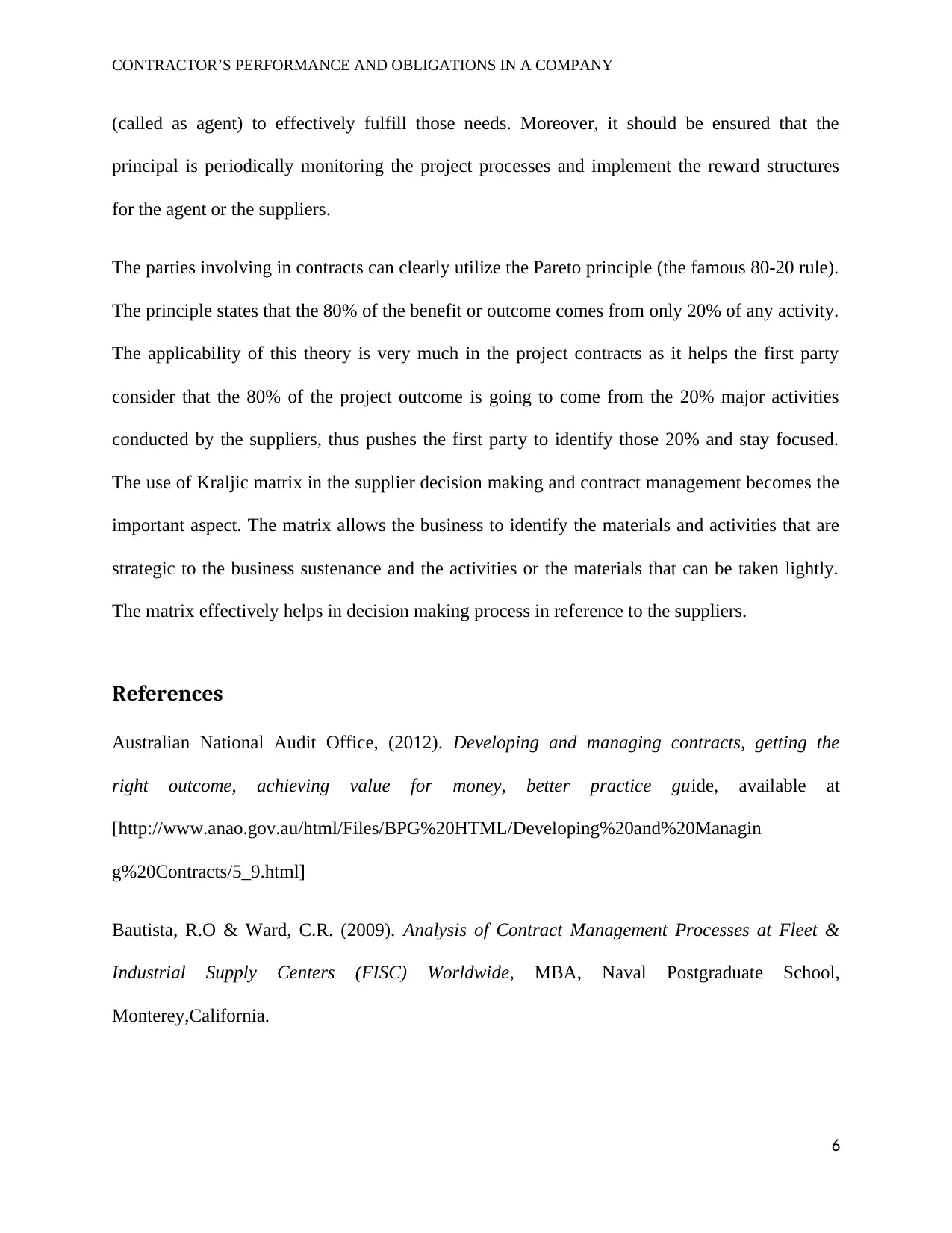
CONTRACTOR’S PERFORMANCE AND OBLIGATIONS IN A COMPANY
(called as agent) to effectively fulfill those needs. Moreover, it should be ensured that the
principal is periodically monitoring the project processes and implement the reward structures
for the agent or the suppliers.
The parties involving in contracts can clearly utilize the Pareto principle (the famous 80-20 rule).
The principle states that the 80% of the benefit or outcome comes from only 20% of any activity.
The applicability of this theory is very much in the project contracts as it helps the first party
consider that the 80% of the project outcome is going to come from the 20% major activities
conducted by the suppliers, thus pushes the first party to identify those 20% and stay focused.
The use of Kraljic matrix in the supplier decision making and contract management becomes the
important aspect. The matrix allows the business to identify the materials and activities that are
strategic to the business sustenance and the activities or the materials that can be taken lightly.
The matrix effectively helps in decision making process in reference to the suppliers.
References
Australian National Audit Office, (2012). Developing and managing contracts, getting the
right outcome, achieving value for money, better practice guide, available at
[http://www.anao.gov.au/html/Files/BPG%20HTML/Developing%20and%20Managin
g%20Contracts/5_9.html]
Bautista, R.O & Ward, C.R. (2009). Analysis of Contract Management Processes at Fleet &
Industrial Supply Centers (FISC) Worldwide, MBA, Naval Postgraduate School,
Monterey,California.
6
(called as agent) to effectively fulfill those needs. Moreover, it should be ensured that the
principal is periodically monitoring the project processes and implement the reward structures
for the agent or the suppliers.
The parties involving in contracts can clearly utilize the Pareto principle (the famous 80-20 rule).
The principle states that the 80% of the benefit or outcome comes from only 20% of any activity.
The applicability of this theory is very much in the project contracts as it helps the first party
consider that the 80% of the project outcome is going to come from the 20% major activities
conducted by the suppliers, thus pushes the first party to identify those 20% and stay focused.
The use of Kraljic matrix in the supplier decision making and contract management becomes the
important aspect. The matrix allows the business to identify the materials and activities that are
strategic to the business sustenance and the activities or the materials that can be taken lightly.
The matrix effectively helps in decision making process in reference to the suppliers.
References
Australian National Audit Office, (2012). Developing and managing contracts, getting the
right outcome, achieving value for money, better practice guide, available at
[http://www.anao.gov.au/html/Files/BPG%20HTML/Developing%20and%20Managin
g%20Contracts/5_9.html]
Bautista, R.O & Ward, C.R. (2009). Analysis of Contract Management Processes at Fleet &
Industrial Supply Centers (FISC) Worldwide, MBA, Naval Postgraduate School,
Monterey,California.
6
Paraphrase This Document
Need a fresh take? Get an instant paraphrase of this document with our AI Paraphraser
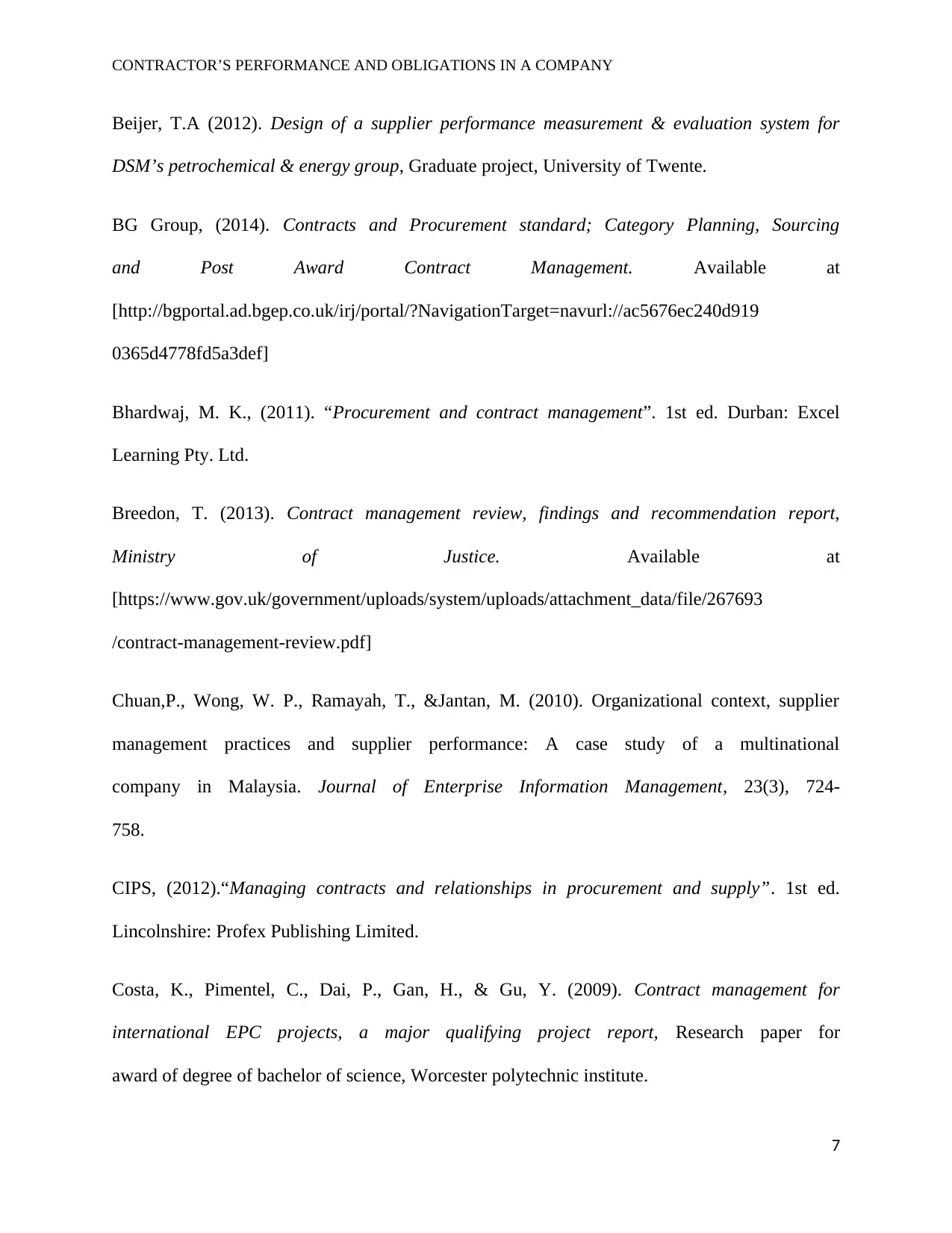
CONTRACTOR’S PERFORMANCE AND OBLIGATIONS IN A COMPANY
Beijer, T.A (2012). Design of a supplier performance measurement & evaluation system for
DSM’s petrochemical & energy group, Graduate project, University of Twente.
BG Group, (2014). Contracts and Procurement standard; Category Planning, Sourcing
and Post Award Contract Management. Available at
[http://bgportal.ad.bgep.co.uk/irj/portal/?NavigationTarget=navurl://ac5676ec240d919
0365d4778fd5a3def]
Bhardwaj, M. K., (2011). “Procurement and contract management”. 1st ed. Durban: Excel
Learning Pty. Ltd.
Breedon, T. (2013). Contract management review, findings and recommendation report,
Ministry of Justice. Available at
[https://www.gov.uk/government/uploads/system/uploads/attachment_data/file/267693
/contract-management-review.pdf]
Chuan,P., Wong, W. P., Ramayah, T., &Jantan, M. (2010). Organizational context, supplier
management practices and supplier performance: A case study of a multinational
company in Malaysia. Journal of Enterprise Information Management, 23(3), 724-
758.
CIPS, (2012).“Managing contracts and relationships in procurement and supply”. 1st ed.
Lincolnshire: Profex Publishing Limited.
Costa, K., Pimentel, C., Dai, P., Gan, H., & Gu, Y. (2009). Contract management for
international EPC projects, a major qualifying project report, Research paper for
award of degree of bachelor of science, Worcester polytechnic institute.
7
Beijer, T.A (2012). Design of a supplier performance measurement & evaluation system for
DSM’s petrochemical & energy group, Graduate project, University of Twente.
BG Group, (2014). Contracts and Procurement standard; Category Planning, Sourcing
and Post Award Contract Management. Available at
[http://bgportal.ad.bgep.co.uk/irj/portal/?NavigationTarget=navurl://ac5676ec240d919
0365d4778fd5a3def]
Bhardwaj, M. K., (2011). “Procurement and contract management”. 1st ed. Durban: Excel
Learning Pty. Ltd.
Breedon, T. (2013). Contract management review, findings and recommendation report,
Ministry of Justice. Available at
[https://www.gov.uk/government/uploads/system/uploads/attachment_data/file/267693
/contract-management-review.pdf]
Chuan,P., Wong, W. P., Ramayah, T., &Jantan, M. (2010). Organizational context, supplier
management practices and supplier performance: A case study of a multinational
company in Malaysia. Journal of Enterprise Information Management, 23(3), 724-
758.
CIPS, (2012).“Managing contracts and relationships in procurement and supply”. 1st ed.
Lincolnshire: Profex Publishing Limited.
Costa, K., Pimentel, C., Dai, P., Gan, H., & Gu, Y. (2009). Contract management for
international EPC projects, a major qualifying project report, Research paper for
award of degree of bachelor of science, Worcester polytechnic institute.
7
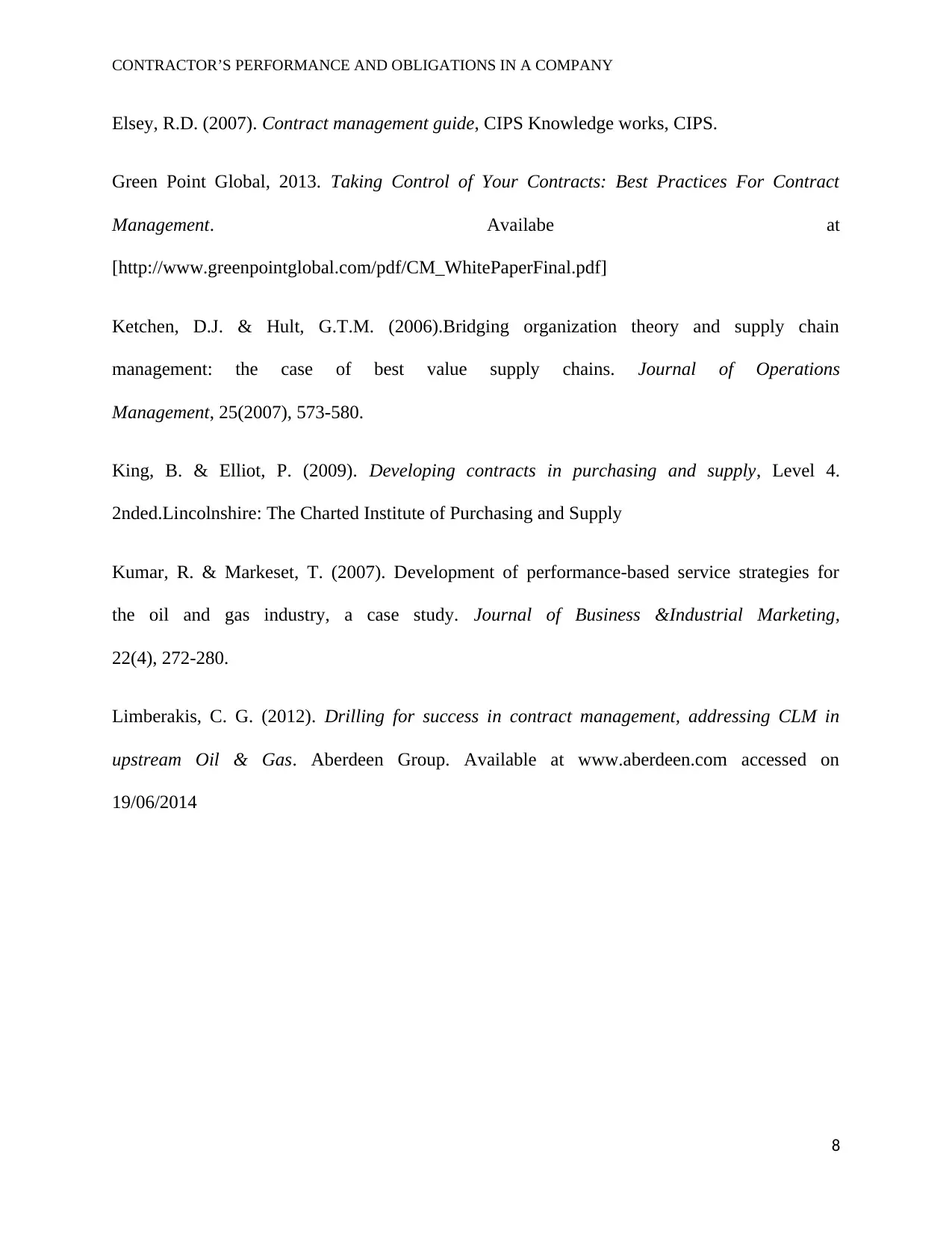
CONTRACTOR’S PERFORMANCE AND OBLIGATIONS IN A COMPANY
Elsey, R.D. (2007). Contract management guide, CIPS Knowledge works, CIPS.
Green Point Global, 2013. Taking Control of Your Contracts: Best Practices For Contract
Management. Availabe at
[http://www.greenpointglobal.com/pdf/CM_WhitePaperFinal.pdf]
Ketchen, D.J. & Hult, G.T.M. (2006).Bridging organization theory and supply chain
management: the case of best value supply chains. Journal of Operations
Management, 25(2007), 573-580.
King, B. & Elliot, P. (2009). Developing contracts in purchasing and supply, Level 4.
2nded.Lincolnshire: The Charted Institute of Purchasing and Supply
Kumar, R. & Markeset, T. (2007). Development of performance-based service strategies for
the oil and gas industry, a case study. Journal of Business &Industrial Marketing,
22(4), 272-280.
Limberakis, C. G. (2012). Drilling for success in contract management, addressing CLM in
upstream Oil & Gas. Aberdeen Group. Available at www.aberdeen.com accessed on
19/06/2014
8
Elsey, R.D. (2007). Contract management guide, CIPS Knowledge works, CIPS.
Green Point Global, 2013. Taking Control of Your Contracts: Best Practices For Contract
Management. Availabe at
[http://www.greenpointglobal.com/pdf/CM_WhitePaperFinal.pdf]
Ketchen, D.J. & Hult, G.T.M. (2006).Bridging organization theory and supply chain
management: the case of best value supply chains. Journal of Operations
Management, 25(2007), 573-580.
King, B. & Elliot, P. (2009). Developing contracts in purchasing and supply, Level 4.
2nded.Lincolnshire: The Charted Institute of Purchasing and Supply
Kumar, R. & Markeset, T. (2007). Development of performance-based service strategies for
the oil and gas industry, a case study. Journal of Business &Industrial Marketing,
22(4), 272-280.
Limberakis, C. G. (2012). Drilling for success in contract management, addressing CLM in
upstream Oil & Gas. Aberdeen Group. Available at www.aberdeen.com accessed on
19/06/2014
8
⊘ This is a preview!⊘
Do you want full access?
Subscribe today to unlock all pages.

Trusted by 1+ million students worldwide
1 out of 9
Related Documents
Your All-in-One AI-Powered Toolkit for Academic Success.
+13062052269
info@desklib.com
Available 24*7 on WhatsApp / Email
![[object Object]](/_next/static/media/star-bottom.7253800d.svg)
Unlock your academic potential
© 2024 | Zucol Services PVT LTD | All rights reserved.



